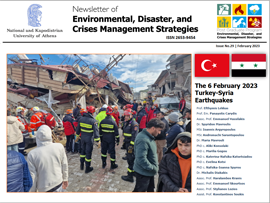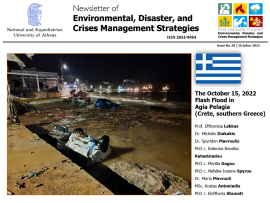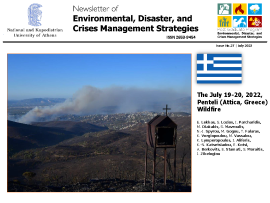The 30th Issue of the “Newsletter of Environmental, Disaster, and Crises Management Strategies”, published under the auspices of the Postgraduate Program "Environmental, Disaster and Crisis Management Strategies" of the National and Kapodistrian University of Athens summarizes the first scientific data from the "Daniel" storm, that hit Thessaly Region on multilple levels in September 2023.
The 30th Issue of the Newsletter of the Environmental, Disaster and Crises Management Stategies is the outcome of a fruitful collaboration and knowledge sharing between geologists, civil engineers, geographers, meteorologists and oceanographers interested in mapping and monitoring the “Daniel” storm and its effects on the natural and built environment and various fields of the daily life in the affected Thessalian Plain and the surrounding semi-mountainous and mountainous areas in the Region of Thessaly. It mainly comprises the following:
- A synoptic analysis of "Daniel" based on theavailable meteorological data and the relatedforecasts.
- The monitoring of "Daniel" and its impact byusing satellite imagery including the storminitiation and evolution, the evolution and thetotal extent of the subsequent flooding, thedetection of the total suspended matter in theadjacent marine environment among othertriggered phenomena and related effects.
- The assessment of the impact of the subsequentflooding on the natural and built environmentincluding residential areas comprising cities,towns and villages of the affected ThessalianPlain and the adjacent semi-mountainous andmountainous areas.
- The assessment of the impact of flooding onrural areas comprising farming husbandry,pastoral husbandry, the livestock and on waterbodies such as waste water plants, dams,lowland reservoirs, pond tanks and water gates.
- The assessment of the direct impact on humanlife including fatalities and injuries as well as theindirect impact during the flood aftermathcomprising the potential for emergence ofcases, outbreaks and epidemics of infectiousdiseases due to the adverse effects in theaffected area.
- The assessment of the impact on the builtenvironment, especially on buildings and criticalinfrastructures comprising the networks of roadsand bridges, railways, telecommunications andelectricity distribution, the embankmentsconstructed along the main overflowed rivers,the port facilities close to river deltas, the watersupply networks and the health facilities.
- The identification and the clarification of themost important risk factors for the occurrence ofinfectious diseases in the storm and floodaffected areas along with the preventionmeasures before, following and after aninfectious disease outbreak based on the recentscientific publications and related guidelines.
- The identification of health and environmentalhazards related to flood waste managementemerging during several phases of debrismanagement and the proposal of measures for the prevention of health impact from disasterwaste management.
In this context, the emergency response actions are also presented along with the contribution of several agencies and volunteer teams to the emergency and the recovery in the storm and flood affected areas of the Thessalian Plain and the surrounding semi-mountainous and mountainous areas.
The volume concludes with general findings on the storm and its impacts and mainly with 10 proposals - actions to reduce the risk of hydrometeorological and geodynamic hazards and their impacts.
The issue is available here.








